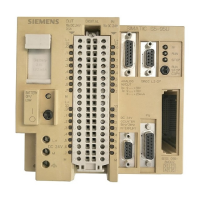Operation
IP244
C79000–B8576–C859–02
2–34
The following table shows the maximum actual values which can be read in.
Conversion time
Sensor Type
50 ms
Jumper D open
°C °F
55 ms
Special function
°C °F
60 ms
Jumper D inserted
°C °F
80 ms
Pt 100 operation
°C °F
Type L
Type J
Type K
Type S
Type R
Pt 100
460 861
467 874
616 1141
3063 5547
2100 3812
Ć Ć
678 1254
688 1270
926 1700
3063 5547
2100 3812
Ć Ć
878 1612
889 1632
1265 2310
3063 5547
2100 3812
Ć Ć
ĆĆ
ĆĆ
ĆĆ
ĆĆ
ĆĆ
850 1562
The characteristics of the thermocouples can be found in DIN 43710 or IEC 584. The
characteristic curve of the Pt 100 can be found in DIN 43760. The characteristics of the
permitted sensors are linearized internally by the firmware. The selection of sensors is made in
the parameter assignment (see Part 3 of this manual).
The maximum actual values which can be read in are indicated if there is a line break.
3.4.3 Setting the Clock
To allow maximum interference suppression at main frequencies of 50 Hz or 60 Hz, the
integration time can be selected.
X7
=50 Hz
112
1
X6/X7
3-3 4-4 Integration time
x 50 Hz mains interference suppression
(20 ms)
x 60 Hz mains interference suppression
(16
2/
3
ms)
12
X6
3.4.4 BASP Evaluation
It is possible to evaluate the BASP signal or to disable the evaluation using jumper X8/4–X9/4.
When BASP = 1, the outputs are disabled.
If there is no BASP evaluation, you must use external measures to make certain that
the machine will be forced into a safe operating state in case of error (see also
IEC 204-1). If the S5-CPU is in STOP, it can no longer react to error messages from the
IP (e.g. actual value too large, watchdog, ...).

